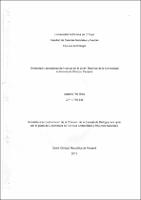Diversidad y abundancia de insectos en el jardín botánico de la Universidad Autónoma de Chiriquí, Panamá.
Abstract
Con el objetivo de determinar la diversidad y abundancia de insectos a nivel de
familia, se realizaron muestreos al azar en hojarascas o suelo y en la parte arbórea
en tres áreas del Jardín Botánico de la UNACHI [específicamente área de laderas
(AL), área de tecal(AT) y elárea plana o arbustiva (APTA)]. Se utilizaron trampas de
caída, red entomológica, trampas de cebo y trampas de luz, durante la época seca
(febrero-mayo de 2010) y época lluviosa (julio-octubre de 2010). La abundancia de la
entomofauna encontrada en el Jardín Botánico de la UNACHI fue de 10 409
individuos, incluidos en 403 morfoespecies, 129 familias y 16 órdenes de la clase
Insecta. Coleoptera e Hymenoptera fueron los órdenes más abundantes durante la
época seca, mientras que Coleoptera y Diptera lo fueron durante la época lluviosa
La morfoespecie 10 de la familia Scarabaeidae fue la más abundante durante la
época seca y lluviosa con 19.9 % y 33.5 %, respectivamente. Índice de diversidad de
Shannon-Weaver para la época seca fue de 3.87 y para la época lluviosa de 3.47, 1o
que demuestra una alta diversidad en ambas. EIAT presentó elmayor Índice de
diversidad durante la época seca (H'=4.10) y lluviosa (H'= 3.86), en comparación con
las otras dos áreas del Jardín Botánico de la UNACHI. Según el Índice de Similitud
de Jaccard, basado en la semejanza de las áreas de muestreo. se obtuvo la mayor
similitud entre EIAL y APTA con 42.3 % y la mayor diferencia se encontró entre El AL
y AT con 35.5 %, durante la época seca. En la época lluviosa la mayor similitud se
encontró entre eIAT y APoA con 41.1 % y la menor diferencia se observó entre El AL
y APoA con 33.5 %. En la época seca la fluctuación de la temperatura y la humedad
en las tres áreas del Jardín Botánico de la UNACHl fue la siguiente: Para EIAL (29.1
'C y 76 %), para el AT (30.9 'C y 72 %) y para el APTA (29.7 'C y 77 %)
respectivamente; durante la época lluviosa: AL (26.6 'C y 84 %). AT (27.7 'C y 84 %)
y en el APoA (26.9 'C y 85 %), lo que indica que estos dos factores pueden afectada
diversidad y abundancia de insectos. Sin embargo, la fluctuación de estos factores
depende de otras condiciones como la cobertura vegetal y la precipitación. With the objective to determine the diversity and abundant of insects to the family
leven, were reviewed in random samplings or soiland leaf litter on the arborea in three
areas of the Botanical Garden of the UNACHI [specifically area of slopes (AL), thecal
area (AT) and the f]at area or shrub (APTA)]. Falls traps were used, entomological
net, bait traps and light traps during the dry season (February-May of 2010) and rainy
season (July-October of 2010). The abundance of the entomofauna found in the
Botanical Garden of the UNACHI was 10 409 individuals including 403
Morphospecies, 129 families and 16 orders of the class inserta. Coleoptera and
Hymenoptera were the orders mast abundant during the dry season, while Coleoptera
and Diptera during the rainy season. The morphospecies 10 of the family
Scarabaeidae was the mast abundant during dry and rainy with 19.9 % and 33.5 %,
respectively. Diversity index of Shannon-Weaver for the dry season was 3.87 and the
rainy season was 3.47, which shows a high diversity in both. The AT had the highest
index of diversity during the dry season (H'=4.10) and rainy (H'= 3.86), compared to
the other areas of Botanical Garden of UNACHI. According to Jaccard similltary
index, based on the slmilitary of the tracts, could be observed the greatest similitary
between the AL and APTA with 42.3 % and the largest difference was found in the AL
and AT with 35.5 %, during the dry season. In the rainy season the greatest similitary
is found in the AT and APTA with 41.1 % and the largent dlfference was observed
between the AL and APoA with 33.5 %. In the dry season the fluctuation of
temperature and humidity in the three areas of the Botanical Garden of the UNACHI
was: for the AL (29.1 'C and 76 %), for the AT (30.9 'C and 72 %) during the rainy
season: AL (26.6 'C and 84 %) AT (27.7 'C and 84 %) and APTA (26.9 'C and 85 %).
indicating that these two factors may affect the diversity and abundance of insects yet
fluctuating factors other conditions such as vegetation cover and precipitation.

